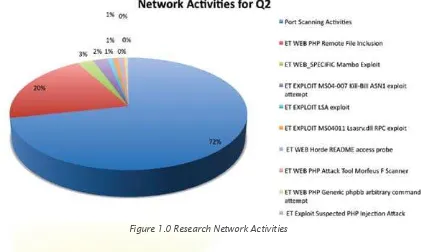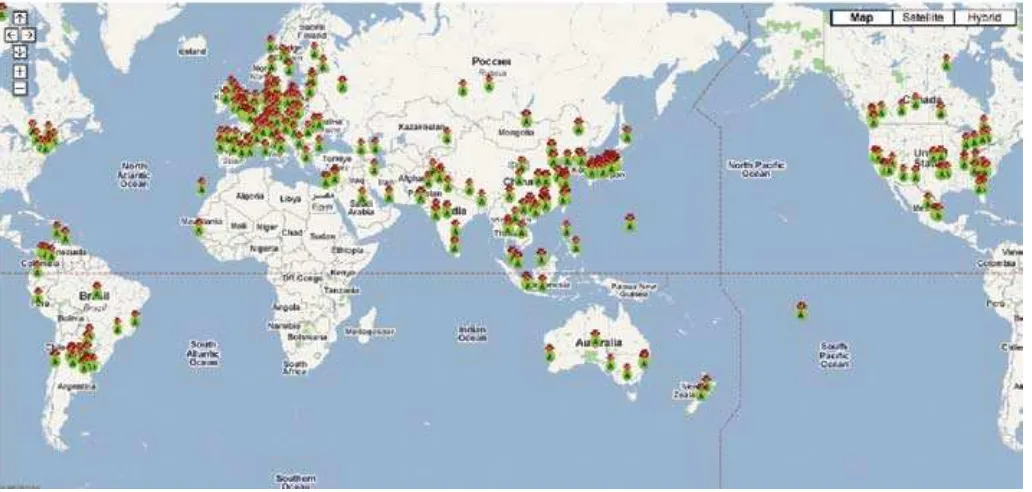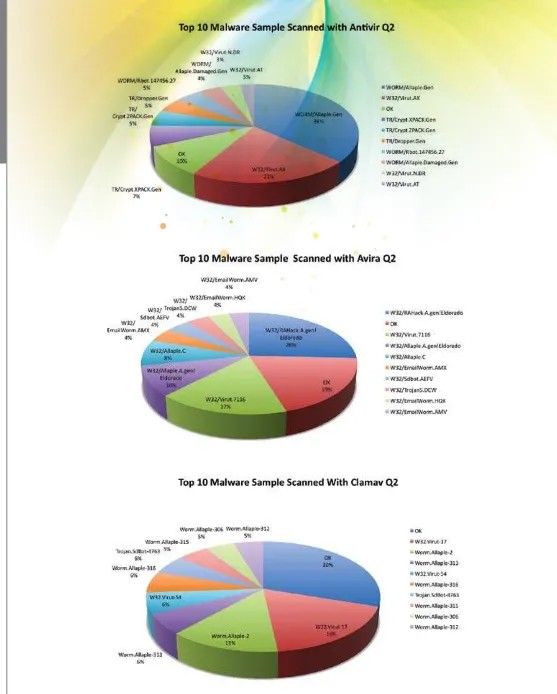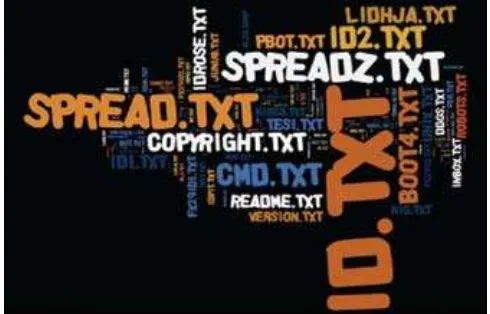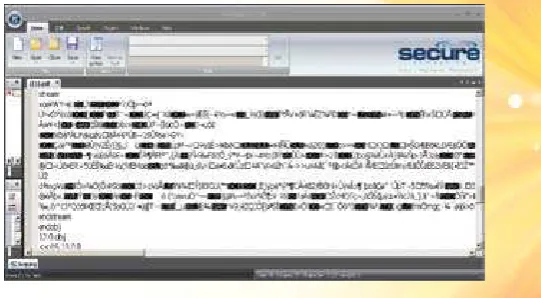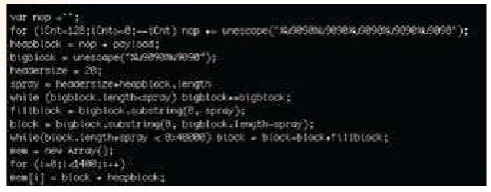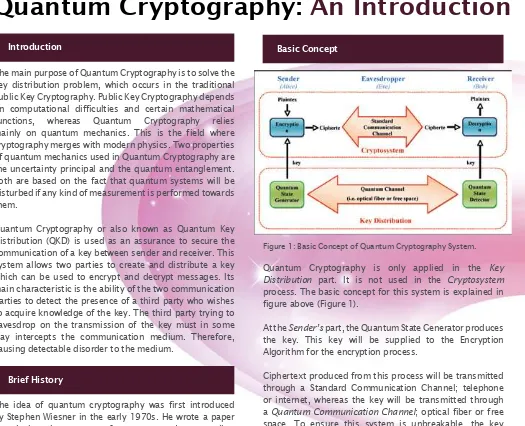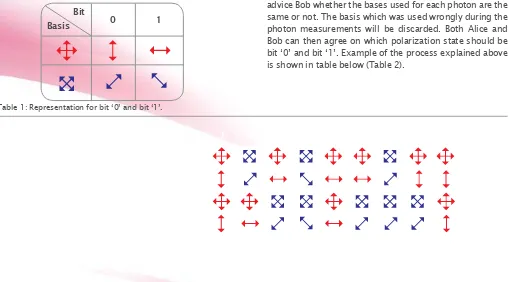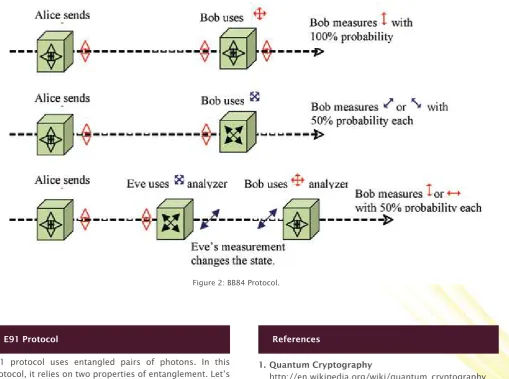Volume 19 - (Q2/2009)
Why Apps Security: Remote File Inclusion (RFI) By Adnan bin Mohd Shukor
adnan@cybersecurity.my
Information Security Management System (ISMS) Internal Audit
By Nuzeita Hashim nuzeita@cybersecurity.my
BCM: Key Steps For A Successful Plan Testing & Exercising
By Naqliyah Bt Zainuddin naqliyah@cybersecurity.my
Gmail Forensic (Memory Analysis) - Part 1 By Kamarul Baharin & Razana Md Salleh bahar@cybersecurity.my
zana@cybersecurity.my MyCERT 2nd Quarter 2009 Summary Report
CyberSecurity Malaysia
Mitigating Information Security Risks in ICT Outsourcing Using ISO/IEC 27001:2005 Controls By Noor Aida Idris
nooraida@cybersecurity.my
Analysis On Malicious PDF File By Mahmud Abdul Rahman mahmud@cybersecurity.my
Digital Forensics First Responder By Mohd Zabri Adil Bin Talib zabri@cybersecurity.my
Microsoft Founder, Bill Gates
Accreditation vs. Certification By Sivanathan Subramaniam siva@cybersecurity.my
Menjamin Kesinambungan Perkhidmatan Perniagaan - Kajian Kes Terhadap Kerosakan Kabel Komunikasi Dasar Laut
By Yati Dato’ Mohamad Yassin & Ahmad Nasir Udin Bin Mohd Zin yati@cybersecurity.my nasir@cybersecurity.my
Protecting Critical Information: Corporate Resilience & Commitment By Abdul Razak Abu Bakar
abdulrazak@cybersecurity.my
Quantum Cryptography: An Introduction Nik Azura Bt Nik Abdullah &
Norul Hidayah Bt. Lot Ahmad Zawawi azura@cybersecurity.my
norul@cybersecurity.my
“ To say a system is secure because no one is attacking it is very dangerous”
2.
From the Editor’s Desk
right to the technical part of capturing memory at a crime scene! Security in outsourcing is also discussed as well as testing Business Continuity plan, Quantum cryptography and many more. Please read them all. You will certainly benefit from those articles. Thanks to all contributors.In Q2 this year, CISSP and SSCP trainings and examinations were conducted. We also saw many important things happened globally. One of them is on the spread of virus Influenza A(H1N1) that has become a pandemic affected substantial number of countries and claimed many lives. For organizations who already have a pandemic plan in place, congratulations! And for others who do not, now it is timely to develop one to ensure no service disruptions in your organization due to the pandemic.
So, what about next quarter? As mentioned by our CEO in his message on SecureAsia@Kuala Lumpur Conference & Exhibition event, please do not miss the opportunity to capture and learn experiences of the invited experts. And for parents, do tag along your kids for the Internet Safety Awareness Seminar!
Next quarter we will also see more training on wireless security, security essentials, CISSP and SSCP. Do check our website for more details.
Thanks again to our contributors and for all of you security professionals and practitioners out there, if you have articles to share with, please email us.
See you in the next publication!
Best Regards
Maslina binti Daud Editor
Greetings to all readers! Welcome to the second edition of eSecurity Bulletin for 2009. I hope the past issues have been informative and provided you a good insight on current information security issues and highlights
The current global economy crisis creates vulnerabilities for new forms of attacks and security breaches. Cyber criminals today are targeting businesses, individuals and critical sectors such as energy, telecommunication and transportation. The services of critical sectors are essential for business operations and livelihood of people. Many of the leading countries are managing these utilities by using control or computerized systems that are networked locally and globally.
In 2007, Estonia was faced with a series of sophisticated cyber attacks against its critical systems and government websites. Estonia was crippled as much of its government and critical services were run online and there was no early warning or defensive mechanism implemented. Cyber criminals are always ahead of the game, working on new strategies and techniques to overcome existing security implementation. The best approach is to establish a working relationship among countries, governments, law enforcement agencies and CERTs. This provides for an efficient platform for information exchange, strategy formulation and a coordinated defense mechanism implementation.
Therefore, we believe people and organisations are the pillars for securing the cyberspace and being informed of the latest threats, mitigating strategies and techniques is the key in order to remain resilient. With that in mind, we have organized a regional cyber security conference called SecureAsia@KL Conference and Exhibition to be held from 7 to 8 July at the Kuala Lumpur Convention Centre.” This event brings regional and international information security experts and industry players countering emerging threats to organisations in the current global and economic uncertainty. We have also organized a special information security awareness raising seminar for parents, teachers and children to share some valuable tips on Internet safety and best practices.
We at CyberSecurity Malaysia believe in human defense that is, to place great emphasize on developing a skilled and knowledgeable workforce to address information security issues. We offer various information security training and awareness programmes for end-users and organisations. You are most welcomed to speak to us of your training needs. Do visit us at www.cybersecurity.my for more information and visit www.esecurity.org.my for tips on internet safety and best practices.
I would like to take this opportunity to thank our contributors who have given their time and support to make this bulletin a success and we always welcome new contributors!
Thank you.
Best Regards
Lt Col (R) Husin Jazri CISSP CEO
CyberSecurity Malaysia E-Security News Highlights for Q2, 2009
MyCERT 2nd Quarter 2009 Summary Report
Mitigating Information Security Risk in ICT Outsourc-ing usOutsourc-ing ISO/IEC 27001:2005 Controls
Analysis On Malicious PDF file
Digital Forensics First Responder
Accreditation vs Certification
Menjamin Kesinambungan Perkhidmatan Perniagaan – Kajian Kes Terhadap Kerosakan Kabel Komunikasi Dasar Laut
Protecting Critical Information: Corporate Resilience & Commitment
PUBLISHED BY
PRODUCED BY
PRINTED BY
CyberSecurity Malaysia (726630-U) Level 7, Sapura@Mines
7, Jalan Tasik, The Mines Resort City 43300 Seri Kembangan
Selangor Darul Ehsan
Equal Media (1590095-D) Block D-10-3, Plaza Kelana Jaya Jalan SS7/13A, 47301 Petaling Jaya Selangor Darul Ehsan, Malaysia Tel / Fax : +603 2274 0753
Percetakan Tujuh Lapan Enam Sdn Bhd (564108-K) No18, Lengkungan Brunei
55100 Pudu, Kuala Lumpur Tel: +603 2732 1422
KKDN License Number: PQ 1780/3724 Web Apps Security: Remote File Inclusion (RFI)
Information Security Management System (ISMS) Internal Audit
BCM: Key Steps For A Successful Plan Testing & Exercising
e-Security News Highlights for Q2, 2009
Ministry To Launch Cyber999 Service In July (June 9, 2009)
CyberSecurity Malaysia, an agency under the Ministry of Science, Technology and Innovation, will launch the Cyber999 Service early next month to provide Internet users with emergency assistance in cyberspace. Deputy Minister of Science, Technology and Innovation, Datuk Fadillah Yusof, said Cyber999 would be the help centre for cyber incident response service especially with the growing threats to cybersecurity.
http://www.bernama.com/bernama/v5/newsbusiness. php?id=416961
Cybersecurity To Push For Standard For Info Security Products (June 19, 2009)
CyberSecurity Malaysia, the country’s vanguard of cyber security, is pushing for the Common Criteria for information security products in Malaysia, which will help businesses especially in identifying the right products.
http://www.bernama.com/bernama/v5/newsgeneral. php?id=419293
US Power Grid Infiltrated (April 8 & 9, 2009)
US national security officials said that the computer networks of the country’s electrical grid and other utilities have been infiltrated and seeded with tools that could potentially be used to disrupt communications, electricity, and other elements of the country’s critical infrastructure.
http://online.wsj.com/article/SB123914805204099085.html
http://fcw.com/Articles/2009/04/08/FERC-needs-to-step-up-
oversight-to-safeguard-grid.aspx
Researchers Observe Botnet Stealing 70 GB Of Data (May 4, 2009)
Researchers at the University of California at Santa Barbara were able to monitor a botnet’s activity for 10 days before the command-and-control instructions were changed. The researchers observed as the botnet harvested 70 GB of data, including email passwords and online banking account information.
http://www.computerworld.com/action/article.do?command=view ArticleBasic&articleId=9132521&source=rss_null17
http://www.theregister.co.uk/2009/05/04/torpig_hijacked/
http://www.cs.ucsb.edu/~seclab/projects/torpig/torpig.pdf
French Council Defangs Plan to Crack Down on Internet Piracy (June 10, 2009)
The highest constitutional body in France defanged the government’s plan to cut off the Internet connections of digital pirates, saying the authorities had no right to do so without obtaining court approval.
http://www.nytimes.com/2009/06/11/technology/internet/11net. html?_r=1
IT Managers Feel Pressured to Relax Security Policies (May 20, 2009)
According to a recent survey of 1,300 IT managers, 86 percent said they were being pressured by company executives, marketing departments, and sales departments to relax web security policies to allow access to web-based platforms such as Google Apps. Nearly half of respondents said some employees bypass security policies to access services like Twitter and Facebook. More than half of the respondents noted that they lacked the means to detect embedded malicious code and prevent URL redirect attacks.
http://searchsecurity.techtarget.com/news article/0,289142,sid14_gci1356896,00.h
Deleted Photos Do Not Always Disappear Right Away (May 21, 2009)
Researchers have found that photos posted on social networking websites are sometimes available even after users have
deleted them. The researchers posted photographs on 16 social networking and Web 2.0 sites, retained records of their associated URLs, and then deleted the images. A month after the pictures were supposed to have been removed, the researchers were able to access them through the URLs on seven of the 16 sites.
http://www.theregister.co.uk/2009/05/21/zombie_photos/
http://news.bbc.co.uk/2/hi/uk_news/8060407.stm
International Telecom Union Publishes Cybercrime Legislation Toolkit (May 24, 2009)
The International Telecommunications Union (ITU) has published a toolkit for cyber crime legislation to provide guidance to countries when developing cyber crime legislation.
http://www.h-online.com/security/ITU-calls-for-global-Microsoft Office 2000 Support Will Expire This Summer (June 1, 2009)
Microsoft has announced that after July 2009, it will issue no more security patches for Office 2000. Office Update and Office Inventory Tool will also be dropped after July; Office Inventory users are urged to switch to Windows Server Update Services. Office 2000 users should also be aware that once support for the software is withdrawn, attackers are likely to target reported vulnerabilities in the software.
http://www.scmagazineuk.com/Microsoft-Office-2000-users- warned-of-potential-malware-attacks-as-final-patching-date-announced/article/137749/
Bill Would Grant President Unprecedented Cyber-security Powers (April 2, 2009)
The Cybersecurity Act of 2009 introduced in the Senate would allow the president to shut down private Internet networks. The legislation also calls for the government to have the authority to demand security data from private networks without regard to any provision of law, regulation, rule or policy restricting such access.
4.
MyCERT
2
nd
Quarter 2009 Summary
Report
Introduction
Incident Trends Q2 2009
This Quarterly Summary provides an overview of activities carried out by MyCERT related to computer security incident handling and trends observed from the research network. The summary highlights statistics of categories of incidents handled by MyCERT in Q2 2009, security advisories released to MyCERT’s constituents, the Malaysian Internet
users, and other activities carried out by MyCERT staff. Do take note that the statistics provided reflect only the total number of incidents handled by MyCERT and not elements such as monetary value or repercussion of the incidents. Computer security incidents handled by MyCERT are those that occur or originate within the Malaysian domain or IP space. MyCERT works closely with other local and global entities to resolve computer security incidents.
From April to June 2009, MyCERT via its Cyber999 service handled a total of 883 incidents. These incidents were referred to MyCERT by members in the constituency and security teams from abroad, in addition to MyCERT’s proactive monitoring efforts.
The following graph shows the total incidents handled by MyCERT in Q2 2009.
In Q2 2009, system intrusion and fraud recorded high number of incidents representing 54% and 16% of incidents handled respectively. System intrusion incidents are generally attributed to web defacement. MyCERT observed that the main cause of defacements were vulnerable web applications. Fraud incidents are mostly phishing sites of local and foreign institutions. In Q2 2009, MyCERT handled Incident Breakdown by Classification Q2 2009
about 43 phishing sites and phishing emails with majority of phishing sites were targeting local brands. MyCERT handled both the source of the phishing emails as well as the removal of the phishing sites found by Internet Service Providers (ISPs). Under the classification of drones and malicious codes in Q2 2009, MyCERT had handled 13% out of total number of incidents. Other examples of incidents within these categories include active botnet controller and hosting of malware or malware configuration files.
Advisories and Alerts
CyberSecurity Malaysia Research Network
In Q2 2009, MyCERT had issued a total of 16 advisories and alerts for its constituency. Most of the advisories in Q2 involved popular end user applications such as Adobe PDF Reader, Adobe Flash, Microsoft Office Power Point, Mozilla Firefox and Microsoft Internet Explorer. Attacker often compromise end users computers by exploiting vulnerabilities in users’ application. Generally, the attacker tricks the user in opening a specially crafted file (i.e. a pdf document) or web page. Readers can visit the following URL on advisories and alerts released by MyCERT in 2009.
http://www.mycert.org.my/en/services/advisories/mycert/2009/main/index.html
Apart from the Cyber999 service, MyCERT also observed activities on its research network and conduct analysis on internet threats and trends. The overall objectives of this initiative are as follow:
• To observe the network for suspicious traffic
simultaneously monitor for the occurrence of known malicious attacks.
• To observe attacker behaviours in order to learn new
techniques being deployed
• To determine the popular techniques that is currently
being used as well as to confirm the continued use of old and well known attack techniques.
• To compile and analyze sufficient relevant information
of which the results can be used to alert the community at large to the possibility of imminent cyber attacks on local networks.
370019
12920
4450
2661
2077 104598
4429
2377
1070 11571 Port Scanning Activities
ET WEB_SPECIFIC Mambo Exploit
ET EXPLOIT LSA Exploit
ET WEB Horde README access probe
ET WEB PHP Generic phpbb arbitrary command attempt
ET WEB PHP Remote File Inclusion
ET EXPLOIT MS04011 Lsasrv.dll RPC exploit
ET WEB PHP Attack Tool Morfeus F Scanner
ET Exploit Suspected PHP Injection Attack ET EXPLOIT MS04-007 Kill-Bill ASN1 exploit attempt
IDS Signatures Total
1. Network Activities
6.
Malware tracking
Software is considered malicious (malware) based on the perceived intent of the creator rather than any particular features. Malware includes computer viruses, worms, trojan horses, most rootkits, spyware, dishonest adware, crimeware and other malicious and unwanted software. Malware is not the same as defective software, that is, software that has a legitimate purpose but contains harmful bugs.
MyCERT has been collecting malware samples automatically since 2007. Out of total 7734 binaries collected in the first quarter of 2009, 760 are unique (based on MD5 hash). For the second quarter of 2009, we observed the number of malware collected is 9561. And samples that are unique (based on MD5 hash), we had collected 672 samples. The malware samples collected are increasing in numbers while the unique malware collected is decreasing.
The figure 1.0 below is the distribution of the source attack to our research network grouped by country. The list of the countries above reflects the nature of the IP addresses coverage of our research network and the way infected computers scan for new targets. The statistic showed not much different compare to previous quarter.
By laying the graph into map, here we can see the the global distribution of binaries downloaded by sensors in the second quarter of 2009.
Figure 1.0 show top ten alerts generated from CyberSecurity Malaysia Research Network intrusion detection systems. More than 70% alert generated are related to port scanning which shows that this technique is used to search for a network host for open ports and most probably, to find specific vulnerability exploit to launch a real attack once the vulnerabilities have been found.
The chart also shows 20% alert are from WEB PHP Remote File Inclusion (RFI). The reason for high number of alert generated is due to a distributed deployment of a web component used to research on Remote File Inclusion (RFI) attacks. Generally, activities on port 22 are related to brute forcing, most of which are automated or carried out by compromised machines
Figure 1.0 Research Network Activities
Attacker trying to spread the malware has actively used the malware sample called Virut during Q2 2009 compare to Q1 2009. Hence we observed that more sample were collected for Virut. Figure 3.0 show the malware variant scanned with multiple antivirus software. We used three antivirus software to identify the collected malware. Below are the top 10 malware classification based on three antivirus software used by MyCERT. MyCERT proactively handled incidents related to malware hosting and escalated the relevant information to the respective parties such as ISPs and international Computer Security Incident Response Teams (CSIRTs)
8.
RFI Tracking
Other Activities
In Q2 2009 MyCERT has detected more than 431,550 attempts of RFI attacks and recorded about 3652 unique domains used as drop sites. MyCERT has proactively handled these incidents and escalated the relevant information to the respective parties such as ISPs and international Computer Security Incident Response Teams (CSIRTs). The following figures 4.0 show the top source of attack and visualization of common names used in RFI scripts (figure 5.0)
In Q2 2009, no crisis or outbreak was observed. Users and organizations are advised to always take measures to protect their systems and networks from threats. MyCERT encourages Malaysian Internet users to be informed of latest computer security threats.
MyCERT can be reached for assistance at:
Malaysia Computer Emergency Response Team (MyCERT) E-mail: mycert@mycert.org.my
Cyber999 Hotline: 1 300 88 2999 Phone: (603) 8992 6969
Fax: (603) 8945 3442 Phone: 019-266 5850 SMS: 019-281 3801 http://www.mycert.org.my/
You can also refer to MyCERT’s website for latest updates on this Quarterly Summary.
MyCERT staff have conducted talks and training in various locations in Q2 2009. The following is a brief list of talks and training conducted by MyCERT in Q2 2009:
• May 2009 - APWG Counter-eCrime Operations Summit
(CeCOS III),Barcelona, Spain, Talk on Malaysia National Report and Case Study.
• May 2009 – Update,F-Secure Tower,KL, Incident Handling
and Threats.
• May 2009 - MSC OSCON 2009, KL, Training on Practical
Analysis With OSS Tools for Web Intrusion.
• May 2009 –Internet Security Awareness, Brunei, Talk on
Internet Security.
• May 2009 – Seminar Keselamatan ICT, Pulau Pinang,
Talk on IT Security.
• June 2009 – Seminar ICT Kebangsaan, Putrajaya, Talk on
Security Risk, How Safe is Safe.
• June 2009 - MSC OSCON 2009, KL, Web Security: Are
Your Web Servers Part of Botnet.
Figure 4.0 Top 10 attackers by IP address
Figure 5.0 Common names used in RFI scripts
10.
Mitigating
Information Security Risks
in ICT Outsourcing using ISO/IEC
27001:2005 Controls
Introduction
Definition of ICT Outsourcing
Information Security Risks in ICT Outsourcing
The popularity of Information Communications Technology (ICT) ICT outsourcing is growing. The enormous competition and current global economic recession faced by organisations have made ICT outsourcing an attractive business decision to trim down their expenses especially in non-core business activities. With outsourcing, organisations can focus on their core business while hiring another organisation to handle other business functions or operations. Outsourcing changes the way business is managed and operated world-wide.
While organisations gain benefits from outsourcing, they must be fully aware that their confidential information could be possibly exposed to substantial risks. This is due to numerous information being exchanged between them and outsourcing providers. Therefore, before organisations decide to outsource their ICT services, they should anticipate the risks, especially information security2 risks, associated to it; and manage these risks accordingly. If they fail to manage the risks, organisation may be faced with loss of business, image and reputation (i.e. due to loss of customer’s trust).
Outsourcing is subcontracting a process, such as product design or manufacturing, to a third-party company1. But what does it really mean? It is an arrangement where an organisation is contracting a particular business function or service to another entity (i.e. individual or outsourcing provider). An example is when a manufacturing company uses an external ICT firm to manage its data centre for duration of time. Another arrangement of outsourcing is when a company hires temporary contractors on an individual basis to deliver an ICT solution (e.g. web application).
Some benefits of outsourcing that organisations enjoy include:
1. Resources (personnel, infrastructure, etc) are focused in delivering core business.
2. Reduce cost where organisations are able to reduce number of employees and their related costs (e.g. remuneration, training fees).
3. Obtain specialized expertise especially in new technology that can increase quality of services offered to customers.
4. Conserve capital for other business ventures.
1
http://en.wikipedia.org/wiki/Outsourcing
In a 2009 Security Mega Trends Survey3 conducted by Ponemon Institute, respondents in IT operations and security were asked to select the biggest risk to organisation’s sensitive and confidential data over the next 12 to 24 months when the survey was conducted. A large percentage of them (IT operations-50% and IT security-59%) believe that outsourcing is the highest risk to organisations. They identified 5 information security risks due to outsourcing:
1. Sensitive or confidential information may not be properly protected.
2. Unauthorised parties might be able to access private files without authorisation.
3. Increased threat of social engineering and cyber crimes.
4. Information may not be properly backed up.
5. Inability to properly identify and authenticate remote users.
2
Information security is defined as preservation of confidentiality, integrity, and availability of information; in addition other properties such as authenticity, accountability, non-repudiation and reliability can also be involved (Source: ISO/IEC 27001:2005 Information Security
Management Systems)
3
Indeed, ICT outsourcing trend in 2009 is growing, and it will likely to continue growing in the next following years. Therefore, it is important for organisations to understand the risks involved in outsourcing their ICT service and mitigate them before making the decision to do so. This article will discuss the 5 information security risks identified in the survey, and provide recommendations on mitigating them. The recommendations provided here mainly refer to the controls listed in Annex A in ISO/IEC 27001:2005 Information Security Management Systems.
Meanwhile, the standard ISO/IEC 27002:2005 Code of Practice for Information Security Management, provides organisations with implementation advice and guidance on best practice in support of the controls.
1. Organisations should ensure all their information is classified according to policies and procedures related to information classification, labelling and handling. This is to ensure confidential information is protected when it is transmitted, processed, stored, or disposed during outsourcing. The policies and procedures should identify the followings:
• Type of information classification (e.g. secret, top
secret) that is allowed to outsourcing providers
• Level of protection required by each classification (e.g.
encryption)
• Types of access (i.e. read, write, own, update, etc) to the
classified information allowed to outsourcing providers
Control A.7.2 Information Classification and A.10.8 Exchange of Information in the standards provide guidance to organisation in formulating policies and procedures related to information classification, labelling and handling.
2. Confidentiality agreement, e.g. Non Disclosure Agreement (NDA) should be produced by organisations to outsourcing providers before the project kicks-off. The NDA should be signed by outsourcing providers to prevent disclosure of confidential information during the arrangement. NDA should identify the following areas:
• Types of information (e.g. confidential information) that
should be protected by outsourcing providers
• Duration of the agreement (including cases where
confidentiality might need to be maintained indefinitely)
• Responsibilities of outsourcing providers to avoid
unauthorised information disclosure
Control A.6.1.5 Confidentiality agreements from the standards provides guidance in formulating requirements for non-disclosure agreements.
How to mitigate Information Security
Risk#1?
Chart 1: Information Security Risks due to Outsourcing Source: 2009 Security Mega Trends Survey
Information Security Risk #1:
Sensitive or confidential information may not be properly protected
Information is critical asset to organisations; especially if the information belongs to their customer. Organisations should ensure the protection of information in order to maintain the trust and confidence of its customers. To do this, organisations shall produce confidentiality agreement to outsourcing providers to protect its confidential information, and prohibit the outsourcing providers from disclosing it to unknown parties (i.e. competitors).
12.
1. Organisations should determine security requirements in providing access control for outsourcing providers; these requirements should address both their business and security needs in outsourcing environment. Based on the security requirements, organisations should produce access control policy and formal procedure for the outsourcing providers to be adhered to. The policies and procedures should cover all stages; from registering outsourcing providers’ personnel to de-registering them when the outsourcing project is completed. The policies and procedures should identify the following areas:
• Access control rules (i.e. explicitly granting access,
need-to-know, single sign-on)
• User access management for outsourcing
providers’ personnel that includes authentication, registration, de-registration, privilege management and password management
• Monitoring system access and use by outsourcing
providers’ personnel
Control A.11 Access Control in the standards provides guidance to organisations in formulating access control policy.
2. Physical security is another aspect that organisations should emphasize prior to outsourcing. If the outsourcing project is implemented within the organisations’ premises, organisations should ensure that the facilities and/or system used during outsourcing are bounded with appropriate security barriers and controls. However, if it is done in the outsourcing providers’ location, organisations should provide their security requirements and policy to outsourcing providers prior to project kick-off. This to ensure outsourcing providers can plan for their physical security. The policies and procedures should include:
How to mitigate Information Security
Risk#2?
Information Security Risk #2:
Unauthorised parties might be able to access private files without authorisation
As part of outsourcing process, organisations need to grant access to outsourcing providers to certain files. These files may contain organisations’ confidential information. Proper authorisation, thus, needs to be provided to outsourcing providers’ authorised personnel to protect these files from unauthorised access, damage, interference and/or alteration.
#2
• Security alarm systems to detect unauthorised accessand alert a response
• Physical barriers to detect and deter unauthorised
entry
• Badges (with photo for clear identification) and/
or physical access, limiting to outsourcing providers’ authorised personnel only
• Locked rooms and cabinets to protect classified
information
Control A.9 Physical and Environmental Security in the standards provides guidance to organisations for preventing unauthorised access, damage or interference to their premise and information.
People security is the main aspect in mitigating both social engineering and cyber crimes threats. Thus, organisations should handle these threats by educating and training outsourcing providers’ employees (those who involved in the outsourcing project) as well as theirs. The education and training should include the followings:
• Organisations’ security policies and procedures • Specific security responsibilities that include who to
report to when encounter with these threats
• Current and/or other security threats
• Basic knowledge of security principles to counter
threats
• Information on disciplinary process
Control 5.2.2 Training, awareness and competence and A.8.2.2 Information security awareness, education and awareness in the standards provide guidance to organisations in developing education and training program.
How to mitigate Information Security
Risk#3?
Information Security Risk #3:
Increased threat of social engineering and cyber crimes
Social engineering is the act of manipulating people into performing actions or divulging confidential information
4
. Social engineering threat in outsourcing is critical to organisation due the involvement of tricking a user into giving, or giving access to, sensitive and confidential information, thereby bypassing most or all implemented protection. Meanwhile cyber crime refers to criminal activity where a computer or network is the source, tool, target, or place of a crime5
Organisations should ensure that adequate backups are implemented in outsourcing arrangement. This to ensure that critical information in outsourcing project can be recovered following a disaster caused by natural, man-made or media failure. It should establish backup policy and procedure that outsourcing providers should follow. The policy and procedure should include the followings:
• Frequency of backup (and appropriate time to do
• Testing of the backup procedure
Control A.10.5 Back-up in the standards provides guidance to organisations for implementing backups.
Organisations should specify remote access rules to their network; this can be achieved via mobile computing and teleworking policy and procedure. The policy and procedure should be informed to outsourcing providers so that they may follow them while working remotely. Remote access to the organisations’ network should be configured and managed so that it:
• Can only be used by specific, authenticated
outsourcing providers’ personnel
• Allows only the specific services needed • Is only available when needed
Control A.11.7.1 Mobile Computing and Communications, and A11.7.2 Teleworking in the standards provide guidance for organisations to develop policy and procedure in mobile computing and teleworking.
How to mitigate Information Security
Risk#4?
How to mitigate Information Security
Risk#5?
Information Security Risk #4:
Information may not be properly backed up
Information Security Risk #5:
Inability to properly identify and authenticate remote users
Backup refers to making copies of data so that these additional copies may be used to restore the original after a data loss event6
. Any lost of information during outsourcing can cause significant security implications (i.e. availability, integrity and confidentiality of information) to organisations. Therefore, organisations should ensure that backups are implemented periodically. If backups are done by outsourcing providers, they should monitor and test the backups periodically.
During outsourcing, working from a remote location (i.e. outsourcing providers’ premise, labs, hotels) usually cannot be avoided; it also may be favoured by the outsourcing providers’ personnel to do their work. Thus, proper identification and authentication need to be performed by organisations to these personnel before granting access to the network.
#4
#5
Conclusion
References
ICT outsourcing holds great promise for organisations. It provides many benefits to improve their productivity and profitability. Also, it creates opportunities to organisations in providing efficient services to their customers. Information security risks inherited by ICT outsourcing, however, needs to be mitigated. It is critical that organisations understand how to manage the 5 information security risks mentioned in this article. They can plan and implement controls as described in ISO/IEC 27001:2005 Information Security Management System and ISO/IEC 27002:2005 Code of Practice for Information Security Management prior to outsource.
1. ISO/IEC 27001:2005 Information Security Management System, First Edition 2005-10-14.
2. ISO/IEC 27002:2005 Code of Practice for Information Security Management First Edition 2005-06-15
3. 2009 Security Mega Trends Survey,
http://www.lumension.com/landing.spring?contentId= 148387&rpLangCode=1, retrieved on 23 January 2009.
4. en.wikipedia.org, retrieved on 23 January 2009.
5. IT Outsourcing Trends, http://www.conferenboard. ca/documents.asp?rnext=1187, retrieved on 23 January 2009.
6. Global Sourcing Trends in 2008, http://www.mondaq. com/article.asp?articleid=57584, retrieved on 23 January 2009.
6
14.
Analysis
On Malicious PDF File
Introduction
Analysis
Analysis on PDF file
Last year was not a good year for Adobe Acrobat Reader users especially those using version below than version 9. Core Security released an advisory to address about util.printf stack buffer overflow bug on Adobe Acrobat Reader with CVE tag CVE-2008-2992. An attacker can exploit this issue to execute arbitrary code with the privileges of the user running the application or crash the application, denying service to legitimate users. Please read the detail description by CoreSecurity researcher about the vulnerability and exploitation analysis for further information.
On 6th November a working exploit was uploaded to milw0rm’s site ready to be abused by bad guy. The code published on the milw0rm is off the shelf exploit code complete with a heap spray exploitation method to have a reliable exploit against the bug. The bug was fixed by Adobe by releasing a new security patch for the version lower than 8.1.13.
We have observed a several misuse of the bug by hosting malicious pdf files on the Internet. The modus operandi involved in luring people to open malicious pdf files by using social engineering attacks. The emails were sent with a link to pdf file, which carries an attachment of the malicious pdf file to trap victim to open the files.
MyCERT of CyberSecurity Malaysia, have collected a few samples of malicious pdf file. In this article we will discuss how analysis is conducted on malicious pdf file.
Based on the discussion in the previous section, the bug is inside Javascript object. Therefore, attacker needs to insert the exploit code into Javascript tag. The problem with this is that, javascript is a programming language that allows the attackers to manipulate how to shape the exploit.
To add to the complexity of this vulnerability of the abuse, the stream inside PDF file can be compressed and encrypted. An attacker can include his or her compressed exploit inside stream tag and make a javascript to add extra protection for his or her exploit. The protection refers to how to make the analysis on the attack become more difficult. Figure 2.0 show a compressed stream with javascript inside the malicious pdf file. We will discuss further the details for this analysis in the next section.
It is always good to start the analysis by scanning the pdf file to identify whether the file is recognized as malicious or otherwise. In this walk-through we will use ClamAV antivirus software. You may also want to scan it with Virustotal’s website. However, it will not be a good idea if the pdf file is legitimate and it is confidential documents as you may potentially share them with others.
In this section we will walk-through the process of analyzing a malicious pdf file. The first analysis is an obvious attack against the bug discussed on section 1.0. In addition, the payload for malicious code also is quite identical and self-explanatory
We begin by scanning the pdf file called doc.pdf (md5: 6c1c23c62526dc78471c97edb3b4abc6) with ClamAV antivirus for a quick detection. Based on Figure 3.0, ClamAV did not detect the file as a malicious file.
PDF File has it own format. It comes with a few portions such as tags for object (1 0 obj << .. >> endobj), stream (steam .. endstream), JavaScript ( /JS .. /Javascript) and etc. If you want to know about other tags inside pdf file, you may want to open it via any text editor. Figure 1.0 show a few tags inside pdf file format.
Figure 1.0: A few tags inside pdf file format
Next, we opened the file with any preferred text editor. In my case, I opened it using a classic vi editor. Scrolling down further inside file, I discovered a javascript function, which contained a few identical variables commonly used inside exploit code. In this case, Figure 4.0 shows javascript found inside doc.pdf. The pdf file is obviously not using any compression format, which makes our analysis easier.
Observing further, we can see that the javascript also contained a set of NOP sleds (%u9090%u9090) referred as no operation in assembly language. The main purpose of having NOP Sled inside exploit code is to have better exploitation process to hits into shellcode rather than hitting to wrong return address or shellcode.
The attacker also implemented heap spray technique to get more reliable exploitation process as per recommended by the original advisory for this vulnerability. The heap spray technique is a technique developed by a security researcher called SkyLined to get a reliable exploitation by manipulating javascript to generate huge memory allocation that allocated shellcode inside the memory region created the attacker. Figure 5.0 shows the heap spray technique used by attacker to get reliable exploitation process.
Scrolling down further we can see the vulnerability exploited by attacker to exploit Adobe Acrobat Reader. Figure 6.0 shows the vulnerability function util.printf as discussed in the previous section.
The analysis for this pdf file is much easier since it is very straightforward. To summarise the analysis, the attacker is using a javascript to exploit adobe util.printf() vulnerability. The payload used in this attack is a unicode shellcode that will establish a reverse connection to malicious server x.x.85.36 on port 7777.
Based on Figure 4.0, we can see clearly the doc.pdf file has been modified by the attacker to inject shellcode by using javascript function. The variable payload is an unescape value containing shellcode. We need to analyze the shellcode and try to understand what the shellcode will execute when the exploitation managed to be executed. In this article, I will only provide a simple shellcode analysis by using libemu’s toolkit called sctest. Details analysis for shellcode is not discussed in this article.
We need to extract payload variable and put it in a different file. We can achieve this by selecting the value inside unescape function. Once, we have shellcode copied into a different file, we need to switch the Unicode format to normal code by replacing the bytes order for each of the characters’ position. Here is perl code that will automate the process of replacing the characters.
Based on new shellcode, we can now move further by feeding the shellcode to sctest. Figure 6.0, shows the shellcode executed inside libemu, and we can see that the shellcode will try to establish a reverse connection to ip x.x.85.36 on port 7777.
Figure 3.0 : ClamAV Detection for PDF file.
Figure 6.0: The shellcode got executed
Figure 5.0: Heap Spray Technique used by attacker
Figure 6.0: Adobe Acrobat Reader util.printf vulnerability used in exploit
Figure 4.0 :Javascript inside doc.pdf file
16.
Mitigation and Prevention Reference:
Conclusion
Based on analysis, we can see that it is difficult to detect any malicious pdf files. The best initial mitigation for this attack is by having an updated version of Adobe Acrobat Reader software. The latest version of Adobe Reader varies from this vulnerability we’re discussing on this article. Please download the latest version of Acrobat Reader from Adobe’s website (http://get.adobe.com/reader/).
To prevent someone from sending any pdf files format to us is not an option. The best way to handle this is by using pgp’s signing process. You only open any pdf files sent by trusted pgp’s key only and not by their email addresses. If you have received any malicious pdf files attachments send by your trusted pgp’s key email address, at least you will know the identity of the sender.
Having latest and updated signature antivirus also helps prevent this attack. Though, relying heavily on antivirus to prevent this attack is a not good practice. Attackers may find ways to bypass antivirus signature and by having javascript enabled, it gives more advantages to attackers to bypass antivirus detection easily.
If your are running on decent modern operating system, please enable and do not turn off of any exploitation prevention technologies like DEP, ASLR and NX.
http://securitylabs.websense.com/content/ Blogs/3411.aspx
http://securitylabs.websense.com/content/ Blogs/3311.aspx
http://web.nvd.nist.gov/view/vuln/detail?vulnId=CVE-2009-0658
http://www.securityfocus.com/archive/1/ archive/1/498032/100/0/threaded
http://secunia.com/advisories/cve_reference/CVE-2008-2992/
The attacks vector is coming from everywhere. The attacks used to target network services for remote exploitation only, are now targeting application or client application itself.
In this article we only focus on Adobe Reader and we believe that the attacks will continue targeting high profile applications. Applications used in daily life like browsers, music or video players, file reader will be favorite targets of the attackers. Thus, please make sure all of our software are patched with latest update. If we already using OS that support ASLR, DEP, NX or any exploitation prevention, please enable it.
By combining the complexity of system for application like javascript engine enable, the exploitation process is getting more reliable. To get reliable exploitations, attackers commonly use heap spray technique. Detecting heap spray behaviors is difficult and we need to analyze the malicious code to figure out about heap allocation inside the process.
Digital Forensics (DF) Principles
Digital
Forensics First Responder
Introduction
When responding to an incident where computer has been used in the commission of crime, as the targets of crime or it contains evidence of crime, special precautions need to be taken. The first person who reacts to an incident is referred as the first responder. In the world of digital forensics, first responders are the most important persons as they play a key role in preserving the digital evidence.
Each responder must clearly understand how fragile digital evidence can be. Digital evidence is latent evidence. Similar to fingerprint and DNA evidence, you need special methods and technique to extract the evidence. Digital, fingerprint and DNA evidence by nature are very fragile.
Special precaution must be taken to document, collect, preserve and examine this type of evidences. The collected exhibits or data can be a valuable source of evidence only if dealt with in an acceptable forensically sound manner.
There are 4 main principles in DF: 1)Evidential integrity:
What is examined must be an exact copy of the original. The exact ‘bit by bit’ copy of the original can be obtained by using imaging technique. Imaging technique will produce mirror copy of the original evidence. The hash value (digital fingerprint) will also be the same as the original. Evidence preservation process will be carried out by the first responder personnel before handing it over to the DF analyst for analysis and examination.
2) Documentation:
First responder must record all action taken during a raid or on-field operation. This is crucial in order to recall all the steps taken. Some people have tendencies to take this matter for granted during documentation process. Imagine if the case prosecution is conducted after 2 years the raid was conducted. It is nearly impossible to recall all the specific procedures and steps taken unless it was properly recorded.
With the documentation, the first responder will be able to give evidence explaining and the implication of their actions to DF analyst to the court.
3) Maintaining chain of custody:
Chain of custody record of the collected exhibits must be properly maintained to ensure the exhibits movement is within the authorized custodian. It is also to ensure the digital exhibits are properly preserved. Failure to maintain the chain of custody record will provide opportunity for defense counsel to create reasonable doubt in the case. First responder must deliver the collected exhibits properly to the DF analyst.
Pic 1: The usage of write blocker (Red oval) will block any writing command to any digital media. It will avoid any tempering on digital evidence, if the exploring and verifying the existence of digital evidence is mandatory, prior to the exhibit collection.
18.
4) Integrity of findings:
All the relevant findings must be documented. It also must be scientifically explainable and also reproducible by other DF analyst. The integrity of the digital evidence can be maintained by the usage of the hash value to confirm the integrity of finding to ensure the exact finding extracted from the seized exhibits. For example, an independent third party should be able to examine the processes taken and achieve the same result (with the same hash value).
Three out of four DF principles are within first responder responsibility. This should clearly explain that evidence preservation process is the most critical part in a DF examination especially when it involves live and running computer server.
Improper handling or preservation method of digital evidence will give a massive impact during DF analysis process.
In responding to a computer incident, the computer is usually discovered in two states which are OFF state or ON state. Below are the basic of the do’s and don’ts recommended by DF Department of CyberSecurity Malaysia.
Dead system (OFF state)
i. Secure and take control of the area containing the equipment
ii. Move people away from any computers and power supplies
iii. Photograph or video the scene and all the components including the leads in situ
iv. Allow any printers to finish printing
v. Do not, in any circumstances, switch the computer on
vi. Make sure that the computer is switched off. Might be screensaver.
vii. Be aware that some laptop computers may power on by opening the lid
viii. Remove the main power source battery from laptop computers
ix. Unplug the power and other devices from sockets on the computer itself (i.e. not the wall socket)
x. Label the ports and cables so that the computer may be reconstructed later
xi. Ensure that all items have signed and completed exhibit labels attached to them
xii. Search the area for diaries, notebooks or pieces of paper with passwords
xiii. Consider asking the user about the setup of the system, including any passwords
xiv. Make detailed notes of all actions taken
Live system (ON state)
a. Secure the area containing the equipment
b. Move people away from computer and power supply c. Photograph or video the scene and all the components
including the leads in situ
d. Consider asking the user about the setup of the system, including any passwords
e. Do not touch the keyboard or click the mouse
f. Consider advice from the owner/user of the computer
g. Allow any printers to finish printing
h. If no specialist advice is available, remove the power supply from the back of the computer without closing down any programs
i. Ensure that all items have signed exhibit labels attached to them
j. Allow the equipment to cool down before removal k. Search area for diaries, notebooks or pieces of paper
with passwords
l. Ensure that detailed notes of all actions are taken
CyberSecurity Malaysia has developed a pocket guide to assist first responders during raid or on-field operation. The interested party can request a copy of the pocket guide by collecting it at DF Department of CyberSecurity Malaysia.
However, it is strongly recommended to have a second opinion before making any critical decision during responding to the incident. The first responder officer must be equipped with digital forensics specialist contact number because on-field investigation can be tricky as first responder will not be working in an entrusted environment.
www.7safe.com/electronic_evidence/ACPO_ guidelines_computer_forensics_evidence.pdf
http://www.ncjrs.gov/pdffiles1/nij/199408.pdf It is important to keep in mind that, in order to produce digital evidence of highest quality, it requires:
a) Special handling and precaution: As we now understand that digital evidence is latent evidence, there are specific ways to preserve it. First responder must clearly understand the dos and don’ts in conducting the evidence preservation process.
b) Special tools: First responder personnel also must be able to conduct imaging process using special tools such as write blocker, live CD, imaging tools and many more. This is to ensure that the preserved evidence is a mirror copy of the original. Once the digital evidence is preserved, DF examination can be done using imaged copy and can be copied as many as the analyst wants for analysis purposes.
c) Trained specialist: The first responder must be properly and sufficiently trained and equipped with correct evidence preservation knowledge. They also must be able to conduct imaging process using special tools such as write blocker, live CD, imaging tools and many more.
Failure to properly handle digital evidence may render digital evidence unusable or may lead to an inaccurate conclusion.
Conclusion
Pic 3: CyberSecurity Malaysia produces its version 1 of “A First Responder’s Pocket Guide For Seizing Digital Evidence”.
Pic 4: Sometimes simple things can be very complicated when working as first responder. They are exposed to various types of technological issues, physical risks and mental pressures during exhibits collection process.
20.
The worldwide acceptance of International standards and compliance programs has been the key factor to facilitate the trans-border movements of goods and services and induce directly tremendous global economic growth. Evidently, ISO (International Organization for Standardization), the world’s largest standard maker, has inventory of more than 17,000 publications. This inventory includes requirements that are unique to individual industrial sectors and those intended for use across multiple sectors.
Standards are adopted by organizations to demonstrate that a person, a system, a product or service, or any of its parts comply with certain requirements as stipulated in the standards. Organizations adopt these standards by going through a strict assessment of conformity in the name of accreditation or certification. The type of accreditation or certification that organizations seek to obtain depends on the mission, goals and objectives of the organizations. Even though, the terms accreditation and certification do not carry the same meaning, both terms are used interchangeably. Unfortunately, many still do not understand the distinctions between these two terms.
With these definitions, one can draw a line to distinguish them in a clearer context. Generally, accreditation is the means that an authoritative body uses to give formal recognition that an organization is competent to carry out the specified tasks. For example, the Digital Forensic Department of CyberSecurity Malaysia is working towards obtaining ASCLD/LAB-International accreditation which is ISO/IEC 17025 program. The key value to this achievement is that the department would be able to demonstrate that it is competent and proficient to perform a task. In this case, it would be its competency to perform certain digital forensic investigative and analysis tasks.
On the other hand, certification is the recognition of conformance to some higher or recognized requirements. In the context of ISO 9001:2000 or ISO 14001:2004, certification refers to the issuing of written assurance (the certificate) by an independent, external body that has audited the organization’s management system and verified that it conforms to the requirements specified in the standard. For example, CyberSecurity Malaysia is ISO 27001 (Information Security Management System) certified. This certification is applicable to the entire organization and it demonstrates that CyberSecurity Malaysia is compliant with ISO 27001 by meeting the recommended range of security controls. The certification has nothing to do with demonstrating competence to perform a task in contrast to accreditation, where one must demonstrate competence to perform a task.
Another example of certification is ISO 9001 (Quality Management Systems - Requirements), which provides a number of requirements which an organization needs to fulfill if it is to achieve customer satisfaction. It assures customers that the organization has a good Quality Management System in place but it plays no role to demonstrate the organization’s competence to perform a task.
In conclusion, accreditation is to demonstrate that an organization is competent to perform a task whereas certification is to demonstrate that an organization meets certain standard requirements. Hence, the use of the term accreditation as alternative to certification is in appropriate because both carry different meanings.
1. What’s in a Name: Accreditation vs Certification? by Roger Muse, 2nd June 2008, http://www.qualitymag.com 2. ISO/IEC 27001:2005 document
3. ISO/IEC 17025:2005 document
4. ASCLD/LAB Supplemental Requirements 2006 document Both accreditation and certification refer to compliance to
certain standards and requirements. Isn’t it sufficient for an organization to accredit or certify against some standards rather then waging a debate on the proper usage of the terms? These two terms, accreditation and certification, have distinctive meanings. They are:
A “third-party attestation related to a conformity assessment body conveying formal demonstration of its competence to carry out specific conformity assessment tasks,” as defined by ISO/IEC 17011 Conformity Assessment - General Requirements for Accreditation Bodies Accrediting Conformity Assessment Bodies.
Accreditation
A “third-party attestation related to products, processes, systems or persons,” as defined by ISO/IEC 17000 Conformity Assessment— Vocabulary and General Principles.
Menjamin Kesinambungan
Perkhidma-tan Perniagaan
– Kajian Kes Terhadap
Kerosakan Kabel Komunikasi Dasar
Laut
Pengenalan
Kajian Kes
Pengurusan Kesinambungan Perniagaan (BCM) memainkan peranan penting dan merupakan asas kepada kesejahteraan sesebuah organisasi. Tanpa perancangan yang mencukupi, sesebuah organisasi mungkin tidak dapat menangani gangguan yang berlanjutan terhadap perkhidmatannya dan memastikan kesinambungan perniagaan dengan berkesan. Prasarana Informasi Kritikal Negara (CNII) merangkumi prasarana kritikal yang mendukung kegiatan ekonomi, politik, strategik dan sosio ekonomi negara. Ia meliputi operasi kerajaan, pasukan pertahanan dan keselamatan, perkhidmatan sektor awam, perbankan dan kewangan, pengangkutan, utiliti, sistem maklumat, telekomunikasi, perubatan dan perkhidmatan kecemasan.
Perkhidmatan internet yang menggunakan kabel komunikasi dasar laut merupakan salah satu perkhidmatan kritikal di bawah sektor telekomunikasi. Dari aspek keselamatan maklumat, faktor ketersediaan (availability) merupakan salah satu elemen terpenting di mana data dan maklumat mestilah boleh diakses pada bila-bila masa ianya diperlukan.
Kabel komunikasi dasar laut merupakan saluran utama perkhidmatan komunikasi, terutamanya di dalam pembekalan perkhidmatan internet, yang menghubungkan pengguna-pengguna internet di seluruh dunia. Walaupun ada teknologi lain seperti penggunaan gelombang mikro dan satelit, kabel komunikasi dasar laut yang menggunakan teknologi optik fiber memberikan sambungan fizikal dan menghasilkan isyarat digital yang lebih baik. Namun begitu, seperti juga sistem gelombang mikro dan satelit yang boleh diganggu oleh cuaca buruk, kabel komunikasi dasar laut juga terdedah kepada kerosakan akibat dari aktiviti penangkapan ikan, terkena sauh kapal dan pergerakan bumi di dasar laut.
Sejak beberapa tahun yang lepas, terdapat beberapa insiden yang telah berlaku dan mengakibatkan gangguan terhadap perkhidmatan kabel telekomunikasi dasar laut.
Kes 1 - Pakistan
Kes 2 - Taiwan
Pada 27 Jun 2005, sebahagian kabel dasar laut SEA-ME-WE3 (South East Asia - Middle East - Western Europe) yang terletak 35 kilometer ke selatan Karachi telah rosak. Insiden ini mengakibatkan gangguan terhadap ke semua komunikasi Pakistan ke luar negara[1]. Kabel dasar laut ini merupakan satu-satunya kabel perhubungan antarabangsa Pakistan bagi sistem telekomunikasi dan internetnya. Sebagai alternatif, Pakistan Telecommunication Company (PTCL) telah menggunakan satelit untuk memberikan perkhidmatan internet dan talian telefon antarabangsa kepada pelanggan-pelanggan utama seperti bank, syarikat penerbangan dan pasaran saham di Karachi.
Pada 26 Disember 2006 gangguan terhadap perkhidmatan internet telah berlaku akibat dari gempa bumi berukuran 7.1 pada skala Richter di Taiwan. Gempa bumi tersebut telah merosakkan kabel dasar laut SEA-WE-ME3 di Taiwan yang telah menyebabkan berjuta-juta pengguna Internet di Asia Timur mengalami gangguan perkhidmatan selama dua bulan. Transaksi kewangan terutamanya pasaran tukaran mata wang asing telah terjejas teruk. Bagaimanapun, kerja-kerja membaik pulih 6 kabel dasar laut tersebut telah selesai pada akhir Februari 2007 [2].
Kes 3 - Vietnam
22.
Kes 4 –Timur Tengah dan Asia Selatan
Pada 30 Januari 2008, benua Eropah, Timur Tengah dan Asia Selatan telah mengalami gangguan perkhidmatan internet akibat kerosakan kabel komunikasi dasar laut. Jaringan komunikasi ini terjejas selepas 2 kabel dasar laut SEA-ME-WE4 dan kabel FEA (FLAG Europe-Asia) yang menghubungkan Eropah dan Asia kepunyaan Flag Telecom, sebuah syarikat yang berpangkalan di India, didakwa mengalami kerosakan akibat terputus. Dua hari kemudian, 2 lagi kabel turut mengalami kerosakan, iaitu satu kabel yang menghubungkan Qatar dan Emiriyah Arab Bersatu kepunyaan Q-Tel, syarikat komunikasi yang berpangkalan
di Qatar dan satu lagi kabel FALCON (Flag – Acatel - Lucent
Optical Network) milik Flag Telecom [4].
Menurut laporan berita Fox News.com, antara negara yang terjejas teruk adalah India, Pakistan, Mesir, Qatar, Arab Saudi, Emiriyah Arab Bersatu, Kuwait dan Bahrain [5]. Negara-negara lain yang dilaporkan turut menerima gangguan kepada perkhidmatan internet akibat dari insiden ini ialah Korea, Malaysia, Thailand, Singapura dan Brunei. Bagaimanapun, gangguan ini telah dapat dipulihkan pada 10 Februari 2008.
Insiden yang berlaku telah memberikan impak ekonomi yang besar kepada negara-negara terbabit. Di Pakistan, insiden ini telah menimbulkan persoalan mengenai masa depan perniagaan pusat panggilan (call centre) di Pakistan. Pakistan mempunyai 25 pengendali pusat panggilan yang memberikan pekerjaan kepada lebih 2,000 orang. Perkhidmatan ini menjana pendapatan industri pusat panggilan sebanyak RM15 juta setahun. Kerajaan Pakistan telah dikritik kerana negara berkenaan bergantung pada satu kabel antarabangsa sahaja tanpa menyediakan sebarang kabel alternatif; tiadanya strategi pemulihan bencana (disaster recovery strategy); dan tidak memiliki sebarang pelan kesinambungan perniagaan (business continuity plan).
Chunghwa Telecom di Taiwan melaporkan bahawa kerosakan kabel berkenaan telah menjejaskan hubungan telefon dan internet di antara Taiwan dengan China, Hong Kong, Malaysia, Singapura, Thailand dan Amerika Syarikat. Kapasiti panggilan telefon antarabangsa telah terjejas sebanyak 40%. Di samping itu, negara China turut melaporkan bahawa perkhidmatan IDD, telefon dan Internet di antara negara berkenaan dengan Amerika Syarikat telah terjejas teruk. The Phillipines Long Distance Company (PLDT) di Filipina melaporkan bahawa kapasiti dan sambungan perhubungan (connectivity) syarikat berkenaan telah berkurangan sebanyak 40%. Smart Communications dan Globe Telecom, dua syarikat komunikasi mobile terbesar di Filipina, melaporkan masalah capaian perhubungan antarabangsa. Kapasiti telefon dan internet yang selebihnya (60%) boleh beroperasi setelah capaian tersebut dialihkan melalui laluan lain ke Amerika Utara,
Impak Kepada Negara Dan Masyarakat
Impak Kepada Negara Dan Masyarakat
Langkah-Langkah Mengatasi Gangguan Perkhidmatan Internet
Rujukan
Timur Tengah, Hawaii, Malaysia dan Singapura. Sementara itu, dua pusat panggilan (call centres) terpaksa ditutup sepenuhnya. Keadaan ini berkemungkinan akan menjadi lebih teruk lagi sekiranya kerosakan tersebut tidak berjaya dipulihkan dalam jangkamasa yang singkat.
Faktor kesediaan merupakan salah satu dari elemen keselamatan maklumat selain daripada kerahsiaan (confidentiality) dan integriti (integrity). Sebarang gangguan akan memberi keesan dimana maklumat tidak dapat diakses oleh pengguna internet.
Mempunyai Jaringan Alternatif
Kebanyakan negara masih bergantung pada kabel dasar laut bagi tujuan komunikasi berbanding penggunaan satelit. Ini adalah kerana, kos penggunaan kabel adalah lebih rendah dan mutu perkhidmatannya adalah baik berbanding dengan satelit. Tetapi sesebuah negara tidak seharusnya bergantung pada hanya sebuah kabel sahaja tetapi perlu mempunyai kabel alternatif sekiranya berlaku gangguan terhadap salah satu dari perkhidmatan kabel dasar lautnya. Sekiranya terdapat sebarang gangguan perkhidmatan, laluan internet tidak akan terjejas dan pengguna akan terus berada di dalam talian. Semua sektor yang menawarkan perkhidmatan menerusi talian, seperti sektor perbankan, perniagaan dan perdagangan juga turut terjamin kepentingannya.
Perlindungan Kepada Prasarana Maklumat Kritikal Negara
Bagi menghalang sebarang kerosakan kepada kabel dasar laut, laluan kabel perlu dilindungi dan dijadikan kawasan larangan. Misalnya, Australian Communications and Multimedia Authority (ACMA) tidak membenarkan sebarang aktiviti yang boleh mendatangkan kerosakan kepada kabel dasar laut negara itu yang terdapat di pantai Perth. Insiden-insiden mengenai gangguan kerosakan pada kabel telekomunikasi dasar laut harus dijadikan iktibar oleh kerajaan untuk memperuntukkan lebih banyak sumber bagi mempertahankan infrastruktur kritikal sebegini. Insiden-insiden berkenaan menunjukkan betapa mudahnya untuk melumpuhkan
Kenyataan dan pandangan yang terdapat dalam artikel ini merupakan pendapat peribadi penulis dan bukan pandangan rasmi CyberSecurity Malaysia.
